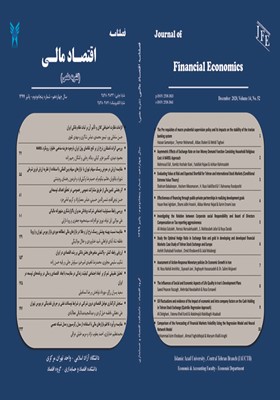بررسی اثرات نامتقارن نرخ ارز بر تابع تقاضای پول ایران با وجود هزینه مذهبی خانوار: رویکرد NARDL
محورهای موضوعی : اقتصاد مالیمحمود عیدی 1 , کامبیز هژبر کیانی 2 , یداله رجایی 3 , اشکان رحیم زاده 4
1 - دانشجوی دکتری ، رشته علوم اقتصادی ، گرایش اقتصاد اسلامی ، دانشگاه آزاد اسلامی واحد زنجان.زنجان.ایران
2 - استاد دانشکده اقتصاد ، دانشگاه شهید بهشتی-تهران. ایران
3 - دانشیار ، دانشکده اقتصاد ، دانشگاه آزاد اسلامی واحد زنجان . زنجان. ایران
4 - استادیار ، دانشکده اقتصاد ، دانشگاه آزاد زنجان .زنجان.ایران
کلید واژه: C32, اقتصاد اسلامی, :تابع تقاضای پول, NARDL, هزینه مذهبی خانوار. طبقه بندی JEL:E41,
چکیده مقاله :
تقاضای پول در هر اقتصاد به عوامل مختلفی بستگی دارد که واکاوی آنها حائز اهمیت است. مطالعات متعددی در زمینه تابع تقاضای پول ایران صورت گرفته که در آنها از متغیرهای توضیحی و روشهای برآورد متفاوتی استفاده شده است. در این پژوهش، نقدینگی (M2) به عنوان متغیر وابسته و تولید ناخالص داخلی، نرخ بهره، هزینه مذهبی خانوار و نرخ ارز آزاد به عنوان متغیرهای توضیحی استفاده گردیدهاند. با توجه به بنیانهای اسلامی در اقتصاد ایران، هزینههای مذهبی خانوار (شهری و روستایی) به عنوان یک عامل مذهبی در تابع تقاضای پول قرار داده شده است. همچنین با استفاده از الگوی خودبازگشتی با وقفه توزیعی غیرخطی (NARDL)، اثر نرخ ارز به صورت نامتقارن بررسی گردیده است. بازه زمانی تحقیق بین سالهای 1376 تا 1396 بوده و دادهها به صورت فصلی هستند. نتایج آزمون کران، نشاندهنده وجود رابطه بلندمدت میان متغیرهای تحقیق است. تولید ناخالص داخلی، نرخ بهره و هزینه مذهبی خانوار دارای اثرات مثبت و معنیدار هستند. همچنین، تغییرات منفی نرخ ارز دارای اثر منفی و معنیدار است، در حالی که تغییرات مثبت نرخ ارز بیمعنی است و بدینترتیب اثرات نامتقارن نرخ ارز بر روی تقاضای پول آشکار میگردد.Money demand depends on different factors in every economy and it’s vital to find them out. Many researches has done about Iran money demand function that differ on explanatory variables or estimation methods. In this research, we use broad money (M2) as dependent variable and GDP, interest rate, household religious cost and exchange rate as explanatory variables. According to the Islamic bases of Iran economy, household religious costs (urban and rural) has involved as a religious factor in money demand function. Also, asymmetric effects of exchange rate has considered by using non-linear autoregressive distributed-lag (NARDL) model. Quarterly data between 1376 and 1396 has employed. By using bounds testing approach, a long run cointegration relation between variables has established. Results show that GDP, interest rate and household religious cost are significantly positive. Exchange rate negative changes has significantly negative effect on money demand. In contrast, exchange rate positive changes is statistically insignificant, imply asymmetric effects of exchange rate on money demand.


